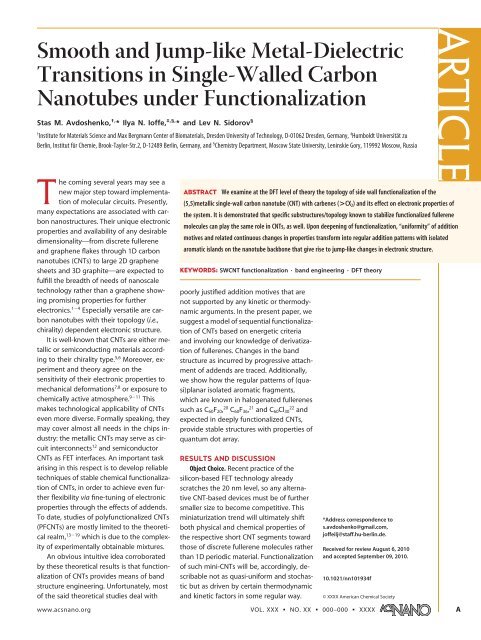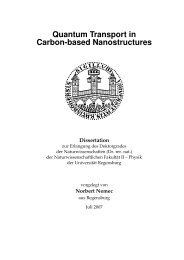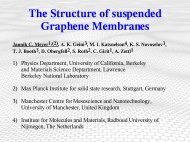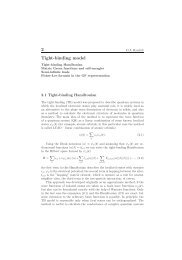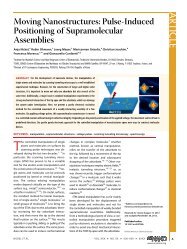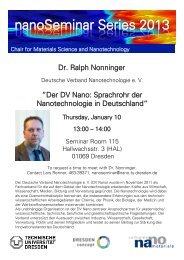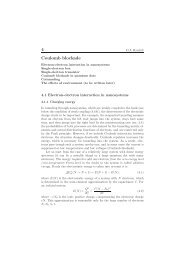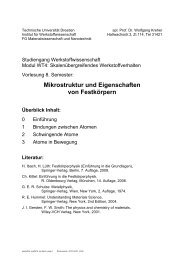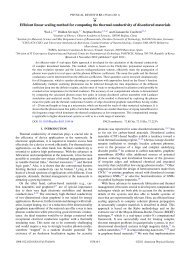online .pdf paper (for personal use only)
online .pdf paper (for personal use only)
online .pdf paper (for personal use only)
You also want an ePaper? Increase the reach of your titles
YUMPU automatically turns print PDFs into web optimized ePapers that Google loves.
Smooth and Jump-like Metal-Dielectric<br />
Transitions in Single-Walled Carbon<br />
Nanotubes under Functionalization<br />
Stas M. Avdoshenko, †, * Ilya N. Ioffe, ‡,§, * and Lev N. Sidorov §<br />
† Institute <strong>for</strong> Materials Science and Max Bergmann Center of Biomaterials, Dresden University of Technology, D-01062 Dresden, Germany, ‡ Humboldt Universität zu<br />
Berlin, Institut für Chemie, Brook-Taylor-Str.2, D-12489 Berlin, Germany, and § Chemistry Department, Moscow State University, Leninskie Gory, 119992 Moscow, Russia<br />
The coming several years may see a<br />
new major step toward implementation<br />
of molecular circuits. Presently,<br />
many expectations are associated with carbon<br />
nanostructures. Their unique electronic<br />
properties and availability of any desirable<br />
dimensionalityOfrom discrete fullerene<br />
and graphene flakes through 1D carbon<br />
nanotubes (CNTs) to large 2D graphene<br />
sheets and 3D graphiteOare expected to<br />
fulfill the breadth of needs of nanoscale<br />
technology rather than a graphene showing<br />
promising properties <strong>for</strong> further<br />
electronics. 14 Especially versatile are carbon<br />
nanotubes with their topology (i.e.,<br />
chirality) dependent electronic structure.<br />
It is well-known that CNTs are either metallic<br />
or semiconducting materials according<br />
to their chirality type. 5,6 Moreover, experiment<br />
and theory agree on the<br />
sensitivity of their electronic properties to<br />
mechanical de<strong>for</strong>mations 7,8 or exposure to<br />
chemically active atmosphere. 911 This<br />
makes technological applicability of CNTs<br />
even more diverse. Formally speaking, they<br />
may cover almost all needs in the chips industry:<br />
the metallic CNTs may serve as circuit<br />
interconnects 12 and semiconductor<br />
CNTs as FET interfaces. An important task<br />
arising in this respect is to develop reliable<br />
techniques of stable chemical functionalization<br />
of CNTs, in order to achieve even further<br />
flexibility via fine-tuning of electronic<br />
properties through the effects of addends.<br />
To date, studies of polyfunctionalized CNTs<br />
(PFCNTs) are mostly limited to the theoretical<br />
realm, 1319 which is due to the complexity<br />
of experimentally obtainable mixtures.<br />
An obvious intuitive idea corroborated<br />
by these theoretical results is that functionalization<br />
of CNTs provides means of band<br />
structure engineering. Un<strong>for</strong>tunately, most<br />
of the said theoretical studies deal with<br />
ABSTRACT We examine at the DFT level of theory the topology of side wall functionalization of the<br />
(5,5)metallic single-wall carbon nanotube (CNT) with carbenes (>CX2) and its effect on electronic properties of<br />
the system. It is demonstrated that specific substructures/topology known to stabilize functionalized fullerene<br />
molecules can play the same role in CNTs, as well. Upon deepening of functionalization, “uni<strong>for</strong>mity” of addition<br />
motives and related continuous changes in properties trans<strong>for</strong>m into regular addition patterns with isolated<br />
aromatic islands on the nanotube backbone that give rise to jump-like changes in electronic structure.<br />
KEYWORDS: SWCNT functionalization · band engineering · DFT theory<br />
poorly justified addition motives that are<br />
not supported by any kinetic or thermodynamic<br />
arguments. In the present <strong>paper</strong>, we<br />
suggest a model of sequential functionalization<br />
of CNTs based on energetic criteria<br />
and involving our knowledge of derivatization<br />
of fullerenes. Changes in the band<br />
structure as incurred by progressive attachment<br />
of addends are traced. Additionally,<br />
we show how the regular patterns of (quasi)planar<br />
isolated aromatic fragments,<br />
which are known in halogenated fullerenes<br />
such as C60F20, 20 C60F36, 21 and C60Cl30 22 and<br />
expected in deeply functionalized CNTs,<br />
provide stable structures with properties of<br />
quantum dot array.<br />
RESULTS AND DISCUSSION<br />
Object Choice. Recent practice of the<br />
silicon-based FET technology already<br />
scratches the 20 nm level, so any alternative<br />
CNT-based devices must be of further<br />
smaller size to become competitive. This<br />
miniaturization trend will ultimately shift<br />
both physical and chemical properties of<br />
the respective short CNT segments toward<br />
those of discrete fullerene molecules rather<br />
than 1D periodic material. Functionalization<br />
of such mini-CNTs will be, accordingly, describable<br />
not as quasi-uni<strong>for</strong>m and stochastic<br />
but as driven by certain thermodynamic<br />
and kinetic factors in some regular way.<br />
*Address correspondence to<br />
s.avdoshenko@gmail.com,<br />
joffeilj@staff.hu-berlin.de.<br />
Received <strong>for</strong> review August 6, 2010<br />
and accepted September 09, 2010.<br />
10.1021/nn101934f<br />
© XXXX American Chemical Society<br />
ARTICLE<br />
www.acsnano.org VOL. XXX ▪ NO. XX ▪ 000–000 ▪ XXXX A
ARTICLE<br />
B<br />
Figure 1. Two-dimensional projection of the supercell of the (5,5)CNT <strong>use</strong>d in periodical calculations with a smaller unit cell<br />
highlighted.<br />
One could expect, <strong>for</strong> example, that at some point<br />
stable isolated aromatic motifs may emerge, similar to<br />
those observed in C60F20,C60F36,C60Cl30, as well as higher<br />
fullerene derivatives. 23 The already quasi-discrete electronic<br />
spectra of such structures will be a function of the<br />
type and particular arrangements of addends. 24,25<br />
For our study, we selected carbene addends that<br />
may be of special interest according to some recent<br />
reports. 26,27 They demonstrate quite a flexibility in<br />
switching between closed cyclopropane and open<br />
bridging con<strong>for</strong>mations that are characterized by sufficiently<br />
different electronic properties. 27 As a backbone,<br />
we consider the (5,5)CNT as the smallest and simplest<br />
metallic tube among those not overstrained sterically.<br />
By functionalizing this metallic nanotube sensitive to<br />
addend attachment, it is theoretically possible to cover<br />
a wide range of band gaps starting from the zero gap in<br />
the pristine CNT.<br />
While the fullerene derivatives are usually presented<br />
as Schlegel diagrams, their 2D projections, 28 we will <strong>use</strong><br />
2D unfoldings <strong>for</strong> nanotube segments, as shown in Figure<br />
1. In this figure, a supercell of the (5,5)CNT <strong>use</strong>d <strong>for</strong><br />
periodic calculations is shown, and a unit cell is highlighted<br />
with black. The choice of the supercell will be<br />
discussed in more detail below.<br />
Distance of Correlation in Polyaddition to a Nanotube. In<br />
polyfunctionalized CNTs, like in many classes of<br />
fullerene derivatives, one could expect rich isomerism.<br />
Hence, the primary task while studying functionalization<br />
is to rationalize the most probable pathways favored<br />
thermodynamically or kinetically. Apparently, at<br />
a certain distance, which may be called “distance of correlation”,<br />
two addends will lose any appreciable mutual<br />
influence. There<strong>for</strong>e, a question arises, whether addition<br />
of two (or more) groups within this distance can<br />
be more favorable than their independent addition at<br />
larger distances. In the case of a positive answer, one<br />
may expect “condensation” of addends around the primarily<br />
<strong>for</strong>med first addition centers. In the opposite<br />
case, one can initially expect independent addition to<br />
the sites spaced by the said distance of correlation or<br />
larger and further slower population of the nanotube<br />
segments thus delimited by the first addends following<br />
several competitive pathways. The difficulties of the experimentalists<br />
in achieving regular addition patterns 18,30<br />
may be indicative of this latter scenario.<br />
Indeed, our calculations <strong>for</strong> CF2 addends confirm<br />
that distant addition of the two groups is much more favorable.<br />
In Figure 2, we provide an energy map <strong>for</strong> various<br />
relative locations of two addends. First of all, one<br />
can see a drastic difference between the two different<br />
types of the nanotube CC bonds. Addition to the<br />
bonds perpendicular to the nanotube axis (type b) appears<br />
to be ca. 120 kJ/mol more favorable than addition<br />
Figure 2. (a) Potential energy profile <strong>for</strong> stretching of CF2-functionalized bonds of types “a” and “b”. (b) Relative energy (kJ/<br />
mol) map <strong>for</strong> various positions of the second attached group with respect to the fixed first one. The results <strong>for</strong> the second<br />
subclass of type a bonds are almost identical and are omitted <strong>for</strong> the reasons of clarity.<br />
VOL. XXX ▪ NO. XX ▪ AVDOSHENKO ET AL. www.acsnano.org
Figure 3. Band structure <strong>for</strong> some exemplary regular CF2 addition motifs of (5,5)CNT with <strong>only</strong> stable type of addition<br />
type b. Only <strong>for</strong> the strongly stressed structure b1, the theoretical band gap is 0.45 eV; the other type b structures demonstrate<br />
a metallic character. O denotes an open con<strong>for</strong>mation of a cage bond.<br />
to those with nonzero longitudinal projection (type a).<br />
This clearly reflects much higher strains in the most<br />
curved perpendicular cross section of the nanotube.<br />
Thus, initial stages of CF2 addition can involve <strong>only</strong> the<br />
perpendicular bonds of the (5,5)CNT in question and,<br />
more generally, the bonds with the least projection on<br />
the nanotube axis in the other chirality types of CNTs.<br />
Additional consequence of stronger steric strains in the<br />
perpendicular direction is open bridging con<strong>for</strong>mations<br />
of the “type a” CF2 addends at least as far as their<br />
number remains low. In addition to preservation of the<br />
sp 2 conjugation, 29 this bond opening in the nanotube<br />
backbone results in favorable decrease of its local effective<br />
curvature. On the contrary, addends of “type b”<br />
tend to <strong>for</strong>m closed cyclopropane con<strong>for</strong>mations. Interestingly,<br />
the respective potential energy minima turn<br />
out to be much more pronounced than that previously<br />
reported <strong>for</strong> C60CF2 26,27 (see Figure 2a). Thus, open and<br />
closed con<strong>for</strong>mations in the CF2-functionalized (5,5)CNT<br />
are much less flexible, and one cannot expect any dynamic<br />
openclose equilibrium. However, as will be<br />
demonstrated below, close attachment of two CF2 addends<br />
may sometimes result in a shift of the potential<br />
energy minimum from open to closed geometry.<br />
Second, the most energetically favorable is addition<br />
of the second group at the very opposite side of the<br />
nanotube wall with respect to the first one. Addition<br />
on the same side (i.e., along a generatrix of a nanotube<br />
cylinder) remains considerably less stable until the spacing<br />
between the two groups reaches 45 hexagons,<br />
which naturaly defines the distance of correlation in<br />
question. Thus, contrary to fullerenes where more thermodynamically<br />
preferable is compact addition and, accordingly,<br />
maximal preservation of the original<br />
-system, (5,5)CNT prefers remote distribution of steric<br />
defects to their concentration. Remote and uncorrelated<br />
initial addition of the first addends and availability<br />
of multiple isoenergetic positions leave space <strong>only</strong><br />
<strong>for</strong> some general ideas about the most probable addition<br />
subpatterns. That is why predefined geometries<br />
proposed in some theoretical studies 14,17 may be a bit<br />
too speculative, and the respective band structure calculations<br />
may be an oversimplification beca<strong>use</strong> of possible<br />
loss of translational symmetry in real-life systems.<br />
Such calculations could be sensible <strong>only</strong> in the case of<br />
weaker dependence of the band structure on particular<br />
addition motifs than on the average addition density.<br />
There<strong>for</strong>e, there directly emerges a task of investigating<br />
the said dependence.<br />
Effect of Addition Motifs on the Band Structure. The calculations<br />
of the band structure were based on a supercell<br />
shown in Figure 1. Though the length of the said cell<br />
equals <strong>only</strong> three hexagons, which is less than the<br />
above determined distance of correlation, consider-<br />
ARTICLE<br />
www.acsnano.org VOL. XXX ▪ NO. XX ▪ 000–000 ▪ XXXX C
ARTICLE<br />
D<br />
Figure 4. Band structure <strong>for</strong> some exemplary regular CF2 addition motifs of (5,5)CNT. For small gap materials, effective<br />
Fermi level is taken as Ef (Ec Ev)/2; otherwise Ef Ev. Behaviors of such fashion can also nicely explain conductance escalation<br />
in work. 30 C and O denote closed and open con<strong>for</strong>mations, respectively.<br />
ation of less dense initial addition based on larger, say,<br />
5-hexagon, supercells does not reveal appreciable band<br />
distortions.<br />
Initially, we considered more thermodynamically<br />
preferable addition patterns with CF2 addends attached<br />
to the type b bonds of Figure 2. The examples of unit<br />
cells of such systems are given in Figure 3. As one can<br />
see, in all cases, the addends <strong>for</strong>m open con<strong>for</strong>mations<br />
thus reducing connectivity of the -system but without<br />
withdrawal of CNT atoms from it. As a result, sometimes<br />
the band gap even does not emerge, that is, the<br />
system remains metallic; in other cases, the gap develops<br />
but stays within 0.5 eV. Interestingly, there is no<br />
clear correlation between the width of the gap and the<br />
number of addends: in particular, addition density of<br />
one CF2 group per supercell provides a semiconducting<br />
system, while with 23 groups, it is again essentially<br />
metallic.<br />
For comparison, we considered some mixed addition<br />
patterns that are less energetically preferable but<br />
still acceptable from the kinetic point of view. Some examples<br />
of such patterns with both type a and type b addition<br />
involved are shown in Figure 4. Here we see<br />
some manifestations of interactions of the adjacent<br />
groups. Whereas the type a groups always <strong>for</strong>m closed<br />
cyclopropane con<strong>for</strong>mations, type b addends are now<br />
not necessarily open. Their con<strong>for</strong>mation depends on<br />
the particular system and even may not correlate with<br />
the local surrounding of the group. The band gap values<br />
<strong>for</strong> these mixed addition patterns are generally<br />
larger than in the pure type b case and may exceed<br />
1.0 eV even with three addends per supercell. Again,<br />
they do not depend monotonously on the addition<br />
density, but the general trend of their broadening<br />
seems quite clear.<br />
The somewhat oscillating results of Figure 4 are difficult<br />
to explain quantitatively. On a qualitative level,<br />
there is interplay of two effects: -electron density polarization<br />
by the electron-withdrawing CF2 groups and<br />
changes in -system topology due to their addition.<br />
The polarizing effect is likely to act toward broadening<br />
of the band gap while the topological consequences<br />
are less straight<strong>for</strong>ward. It is not surprising that very few<br />
addends may create an appreciable band gap in a metallic<br />
tube since the pristine tubes themselves divide<br />
into metallic and semiconducting due to topological<br />
reasons. However, we see that in many cases the band<br />
gaps and the shape of the frontier bands do not change<br />
too much <strong>for</strong> the type a type b patterns with the<br />
same number of addends per supercell.<br />
Thus, two possible cases can be distinguished in initial<br />
stages of functionalization of a metallic (5,5)CNT<br />
with CF2 groups. The thermodynamically preferable<br />
type b addition will generally provide metallic tubes,<br />
though not without exclusions. The stochastic type a<br />
type b addition results in semiconducting structures,<br />
with variable band gaps depending on the addition<br />
density but not in a monotonous way. It is an important<br />
challenge <strong>for</strong> the experimentalists to find out<br />
which addition motifs are synthetically accessible. In<br />
VOL. XXX ▪ NO. XX ▪ AVDOSHENKO ET AL. www.acsnano.org
Figure 5. Calculated band structure <strong>for</strong> (5,5)3(CX2)3 (X H,F) structures <strong>for</strong> open and closed bridge bond cases (see text <strong>for</strong> details). (a)<br />
XY projection of the structure; (b) ZY projection of the structure; (c) band structures, where Me denotes metallic phases.<br />
this respect, quite helpful may be the above-discussed<br />
considerable difference in addition energy between the<br />
type a and type b groups: presence of both types of addends<br />
must result in a much broader spectrum of detachment<br />
energy.<br />
In ref 31, we reported the first successful analysis of<br />
functionalized nanotubes by means of MALDI mass<br />
spectrometry. The development of this work was hampered<br />
by poor reproducibility of the major peaks in the<br />
mass spectra; nevertheless, the nanotube origins of<br />
the signals were doubtless. In view of the above, there<br />
may be a need in MALDI experiments <strong>for</strong> precise control<br />
of the energy density in the laser spot in order to control<br />
and study various degrees of fragmentation via detachment<br />
of addends.<br />
Band Structure in Case of Specific Regular Patterns. Chemistry<br />
of simple fullerene derivatives provides numerous<br />
examples of <strong>for</strong>mation of benzenoid or other aromatic<br />
substructures isolated by addends. The examples include<br />
C60F18, C60F36, and C60Cl30; especially interesting is<br />
the latter one, where the aromatic stabilization energy<br />
proves to be large enough to compensate multiple unfavorable<br />
close contacts of the bulky chlorine addends.<br />
There<strong>for</strong>e, <strong>for</strong>mation of similar aromatic substructures<br />
in polyfunctionalized nanotubes may be the case when<br />
addition is governed thermodynamically.<br />
Some relevant examples <strong>for</strong> (5,5)CNT regularly functionalized<br />
with CF2 and CH2 addends are shown in Figure<br />
5. In cluster calculations, these addition motifs are<br />
ca. 140 kJ/mol more stable than the structures with<br />
the same addition density (5 groups per supercell)<br />
from Figure 4. The stable con<strong>for</strong>mation of the addends<br />
is open, but we also considered the closed cyclopropane<br />
con<strong>for</strong>mation found to lie 30 kJ/mol higher (the<br />
lengths of the cyclopropane CC bonds were taken to<br />
be 1.62 Å as in the closed C60CCl2 molecule 26 ).<br />
Similarly to most of the structures of Figure 4, the<br />
open con<strong>for</strong>mation of the regular structure of Figure 5<br />
retains its metallic properties both with CF2 and CH2 addends.<br />
However, closure of the cyclopropane rings<br />
cuts the -system of the nanotube into disjointed belts<br />
of benzenoid rings and drastically changes the picture.<br />
We observe <strong>for</strong>mation of (almost) flat frontier bands<br />
separated by a gap equal (CH2) or higher than the<br />
HOMOLUMO gap in C60. With the donor CH2 groups,<br />
the screening of the conjugated fragments is somewhat<br />
imperfect, which results in finite, though very high, effective<br />
masses while the electron-withdrawing CF2 addends<br />
lead to <strong>for</strong>mation of two perfect deep levels.<br />
This drastic change of electronic structure due to<br />
trans<strong>for</strong>mation of open CF2 bridges into cyclopropane<br />
fragments deserves serious attention in the light of the<br />
findings of previous work, 26,27 where it was demonstrated<br />
that the analogous con<strong>for</strong>mational change in<br />
C60CF2 may be easily effected by charging or application<br />
of the electric field. One can hypothesize that<br />
gradual charging of the discussed nanotube systems<br />
may initiate a chain of con<strong>for</strong>mational transitions<br />
through partial or equilibrium to complete closure of<br />
CX2 groups with associated changes in conductivity.<br />
ARTICLE<br />
www.acsnano.org VOL. XXX ▪ NO. XX ▪ 000–000 ▪ XXXX E
ARTICLE<br />
F<br />
This may provide a uniquely flexible molecular switching<br />
system, provided, however, that regular patterns of<br />
addends are achievable synthetically.<br />
CONCLUSIONS<br />
The present study has demonstrated that functionalization<br />
of metallic (5,5)CNTs by CF species or similar<br />
nature groups may not <strong>only</strong> lead to smooth metaldielectric<br />
transition with the increasing degree of attachment<br />
but also yield such remarkable systems where<br />
transitions of electric properties might be controlled<br />
electrically. Nowadays, however, the comm<strong>only</strong> synthetically<br />
available nanotubes are usually of larger diameter<br />
than the (5,5)CNT. For those larger tubes, one<br />
could expect certain deviations from the findings of the<br />
present work. In particular, steric effects of gradual decrease<br />
of the tube curvature (i.e., of approach to the<br />
graphene limit) may favor closed con<strong>for</strong>mations of the<br />
CX2 addends even in the case of type a addition. Thus,<br />
each addend will have a destructive effect on the<br />
-conjugated system of a nanotube, which, in its turn,<br />
may bring about different regiochemical principles of<br />
METHODS<br />
The present study is based on the KohnSham 32 DFT widely<br />
known to be a fast and relatively inexpensive technique <strong>for</strong> investigation<br />
of the large-scale systems. With GGA (or better)<br />
exchange-correlation functionals, it usually demonstrates good<br />
agreement between experiment and theory <strong>for</strong> both molecular<br />
and periodic fullerene systems. 3336 The electronic properties of<br />
the periodic systems were calculated with the <strong>use</strong> of the CRYS-<br />
TAL06 package 37 and molecular calculations using the PRIRODA<br />
code 38 with the PBE 39 exchange-correlation functional.<br />
For a typical periodic task in the case of pristine and regularly<br />
functionalized CNTs, the numbers of k-points were chosen<br />
to achieve 10 6 au Fermi energy convergence. Generally, it required<br />
about 24 k-points. Smaller 3-21G atomic basis set was<br />
<strong>use</strong>d <strong>for</strong> the full periodic optimizations since no significant<br />
changes in geometry and electronic properties were observed<br />
with more accurate 6-31G and 6-31G* basis sets (does not<br />
change drastically a geometry or an electronic property). All molecular<br />
calculations were per<strong>for</strong>med at the DFT|PBE|TZ2p 39,40<br />
level of theory with optimization tolerance of 10 5 au.<br />
As an additional test of the quality of the periodic calculations<br />
with their smaller basis sets, <strong>for</strong> verification, we per<strong>for</strong>med<br />
molecular calculations <strong>for</strong> the supercells selected. We found that<br />
deviations in geometric parameters were always within 0.005 Å,<br />
and those of the HOMOLUMO gaps were within <strong>only</strong> 0.05 eV.<br />
Acknowledgment. S.A. is thankful <strong>for</strong> financial support from<br />
the Erasmus Mundus programme External Co-operation (EM<br />
ECW-L04 TUD 08-11). This work has been supported by the RFBR<br />
Grant 09-03-00353.<br />
REFERENCES AND NOTES<br />
1. Iijima, S.; Ichihashi, T. Single-Shell Carbon Nanotubes of 1nm<br />
Diameter. Nature 1993, 363, 603–605.<br />
2. Dekker, C. Carbon Nanotubes as Molecular Quantum<br />
Wires. Phys. Today 1999, 52, 22–28.<br />
3. Novoselov, K. Graphene: Mind the Gap. Nat. Mater. 2007,<br />
6, 720.<br />
4. Ponomarenko, L. A.; Schedin, F.; Katsnelson, M. I.; Yang, R.;<br />
Hill, E. W.; Novoselov, K. S.; Geim, A. K. Chaotic Dirac<br />
Billiard in Graphene Quantum Dots. Science 2008,<br />
356–358.<br />
multiple CX2 attachment. There<strong>for</strong>e, functionalization<br />
of larger CNTs deserves further theoretical studies purported,<br />
in particular, to find the range of nanotube sizes<br />
where the herein described behavior of the (5,5)CNT<br />
will be paralleled. Such studies can follow the strategy<br />
of the present work, that is, going from regiochemistry<br />
and energetic of addition to band structures. Of special<br />
interest may also be those “intermediate” nanotube diameters<br />
where open and closed con<strong>for</strong>mations of CX2<br />
groups will be in a sort of equilibrium like in C60CF2.<br />
There is also a strong need <strong>for</strong> experimental studies of<br />
the CX2-modified nanotubes to verify the theoretical<br />
findings of the present work. Most importantly, this is<br />
the question of regioselectivity in functionalization,<br />
which, as we demonstrate, may be of definitive importance<br />
with regard to further aspects of direct practical<br />
significance, such as band structure. Furthermore, it<br />
would be very desirable to find diverse regimes of carbene<br />
attachment in order to have a choice between<br />
more chaotic and more regular (e.g., thermodynamic)<br />
structures.<br />
5. Dresselhaus, M. S.; Dresselhaus, G.; Eklund, E. P. Science of<br />
Fullerenes and Carbon Nanotubes; Academic Press: New<br />
York, 1996.<br />
6. Charlier, J.-C.; Blase, X.; Roche, S. Electronic and Transport<br />
Properties of Nanotubes. Rev. Mod. Phys. 2007, 79,<br />
677–732.<br />
7. Park, C. J.; Kim, Y. H.; Chang, K. J. Band-Gap Modification<br />
by Radial De<strong>for</strong>mation in Carbon Nanotubes. Phys. Rev. B<br />
1999, 60, 10656–10659.<br />
8. Chan, B.; Lakatos, G. V.; Peng, S.; Cho, K. First-Principles<br />
Study of Band-Gap Change in De<strong>for</strong>med Nanotubes. Appl.<br />
Phys. Lett. 2005, 87, 173109.<br />
9. Picozzi, S.; Santucci, S.; Lozzi, L.; Valentini, L.; Delley, B.<br />
Ozone Adsorption on Carbon Nanotubes: The Role of<br />
Stone-Wales Defects. J. Chem. Phys. 2004, 120, 7147–52.<br />
10. Li, Y.; Zhou, Z.; Zhao, J. Trans<strong>for</strong>mation from<br />
Chemisorption to Physisorption with Tube Diameter and<br />
Gas Concentration: Computational Studies on NH3<br />
Adsorption in BN Nanotubes. J. Chem. Phys. 2007, 127,<br />
184705.<br />
11. Okazaki, T.; Okubo, S.; Nakanishi, T.; Joung, S.-K.; Saito, T.;<br />
Otani, M.; Okada, S.; Bandow, S.; Iijima, S. Optical Band Gap<br />
Modification of Single-Walled Carbon Nanotubes by<br />
Encapsulated Fullerenes. J. Am. Chem. Soc. 2008, 130,<br />
4122–4128.<br />
12. Raychowdhury, A.; Roy, K. Modeling of Metallic Carbon-<br />
Nanotube Interconnects <strong>for</strong> Circuit Simulations and a<br />
Comparison with Cu Interconnects <strong>for</strong> Scaled<br />
Technologies. Comput.-Aided Des. Integr. Circuits Syst. 2006,<br />
25, 58–65.<br />
13. Bettinger, H. F.; Kudin, K. N.; Sc<strong>use</strong>ria, G. E.<br />
Thermochemistry of Fluorinated Single Wall Carbon<br />
Nanotubes. J. Am. Chem. Soc. 2001, 123, 12849–12856.<br />
14. Zhao, J.; Chen, Z.; Zhou, Z.; Park, H.; Schleyer, P. R.; Lu, J. P.<br />
Engineering the Electronic Structure of Single-Walled<br />
Carbon Nanotubes by Chemical Functionalization. Chem.<br />
Phys. Chem. 2005, 6, 598–601.<br />
15. Lee, Y.-S.; Nardelli, M. B.; Marzari, N. Band Structure and<br />
Quantum Conductance of Nanostructures from Maximally<br />
Localized Wannier Functions: The Case of Functionalized<br />
Carbon Nanotubes. Phys. Rev. Lett. 2005, 95, 76804.<br />
VOL. XXX ▪ NO. XX ▪ AVDOSHENKO ET AL. www.acsnano.org
16. Pan, H.; Feng, Y. P.; Lin, J. Y. Ab Initio Study of F- and Cl-<br />
Functionalized Single Wall Carbon Nanotubes. J. Phys.:<br />
Condens. Mater. 2006, 18, 5175–5184.<br />
17. Ranjan, N.; Seifert, G. Transport Properties of<br />
Functionalized Carbon Nanotubes: Density-Functional<br />
Green’s Function Calculations. Phys. Rev. B 2006, 73,<br />
153408.<br />
18. Park, H.; Zhao, J.; Lu, J.-P. Effects of Sidewall<br />
Functionalization on Conducting Properties of Single Wall<br />
Carbon Nanotubes. Nano Lett. 2006, 6, 916–919.<br />
19. Lim, S.-H.; Ji, W.; Lin, J. First-Principles Study of Carbon<br />
Nanotubes with Bamboo-Shape and PentagonPentagon<br />
Fusion Defects. J. Nanosci. Nanotechnol. 2008, 8, 309–313.<br />
20. Boltalina, O. V.; Markov, V. Yu.; Troshin, P. A.; Darwish, A. D.;<br />
Street, J. M.; Taylor, R. C60F20: “Saturnen”, an Extraordinary<br />
Squashed Fullerene. Angew. Chem., Int. Ed. 2001, 40,<br />
787–789.<br />
21. Jenkins, S.; Heggie, M. I.; Taylor, R. Aromaticity of [60]-<br />
Fullerene Derivatives (C60 Xn,X H, F; n 18, 36)<br />
Constrained To Have Planar Hexagonal Rings. J. Chem.<br />
Soc., Perkin Trans. 2 2000, 2415–2419.<br />
22. Troshin, P. A.; Lyubovskaya, R. N.; Ioffe, I. N.; Shustova,<br />
N. B.; Kemnitz, E.; Troyanov, S. I. Synthesis and Structure of<br />
the Highly Chlorinated [60]Fullerene C60Cl30 with Drum-<br />
Shaped Carbon Cage. Angew. Chem., Int. Ed. 2005, 44, 234–<br />
237.<br />
23. Kareev, I. E.; Kuvychko, I. V.; Shustova, N. B.; Lebedkin, S. F.;<br />
Bubnov, V. P.; Anderson, O. P.; Popov, A. A.; Boltalina, O. V.;<br />
Strauss, S. H. C1-(C84-C2(11))(CF3)12: Trifluoromethylation<br />
Yields Structural Proof of a Minor C84 Cage and Reveals a<br />
Principle of Higher Fullerene Reactivity. Angew. Chem., Int.<br />
Ed. 2008, 47, 6204–6207.<br />
24. Ioffe, I. N.; Avdoshenko, S. M.; Boltalina, O. V.; Sidorov, L. N.;<br />
Berndt, K.; Weber, J. M.; Kappes., M. M. Photoelectron<br />
Spectroscopy and Quantum Chemical Studies of C60F34<br />
Int. J. Mass Spectrom. 2005, 243, 223–237.<br />
25. Popov, A. A.; Kareev, I. E.; Shustova, N. B.; Stukalin, E. B.;<br />
Lebedkin, S. F.; Seppelt, K.; Strauss, S. H.; Boltalina, O. V.;<br />
Dunsch, L. Electrochemical, Spectroscopic, and DFT Study<br />
of C60(CF3)n Frontier Orbitals (n 218): The Link<br />
between Double Bonds in Pentagons and Reduction<br />
Potentials. J. Am. Chem. Soc. 2007, 11551–11568.<br />
26. Pimenova, A. S.; Kozlov, A. A.; Goryunkov, A. A.; Markov,<br />
V.Yu.; Khavrel, P. A.; Avdoshenko, S. M.; Vorobiev, V. A.;<br />
Ioffe, I. N.; Sakharov, S. G.; Troyanov, S. I.; et al. Preparation<br />
and Structures of [6,6]-Open[60]Fullerenes: C60(CF2) and<br />
C60(CF2)2. Dalton Trans. 2007, 5322–5328.<br />
27. Pimenova, A. S.; Kozlov, A. A.; Goryunkov, A. A.; Markov, V.<br />
Yu.; Khavrel, P. A.; Avdoshenko, S. M.; Ioffe, I. N.; Sakharov,<br />
S. G.; Troyanov, S. I.; Sidorov, L. N. Synthesis and<br />
Characterization of Difluoromethylene-<br />
HOMO[60]Fullerene, C60CF2. Chem. Commun. 2007,<br />
374–376.<br />
28. Glukhovtsev, M. N.; Pross, A.; Schlegel, H. B.; Bach, R. D.;<br />
Radom, L. Gas-Phase Identity SN2 Reactions of Halide<br />
Anions and Methyl Halides with Retention of<br />
Configuration. J. Am. Chem. Soc. 1996, 118, 11258–11264.<br />
29. Dubois, S. M. M.; Lopez-Bezanilla, A.; Cresti, A.; Triozon, F.;<br />
Biel, B.; Charlier, J.-C.; Roche, S. Quantum Transport in<br />
Graphene Nanoribbons: Effects of Edge Reconstruction<br />
and Chemical Reactivity. ACS Nano 2010, 4, 1971–1976.<br />
30. Cabana, J.; Martel, R. Probing the Reversibility of Sidewall<br />
Functionalization Using Carbon Nanotube Transistors.<br />
J. Am. Chem. Soc. 2007, 129, 2244–2245.<br />
31. Avdoshenko, S. M.; Ioffe, I. N.; Kozlov, A. A.; Markov, V. Yu.;<br />
Nikolaev, E. N.; Sidorov, L. N. Novel Possibilities in the<br />
Study of Isolated Carbon Nanotubes. Rapid Commun. Mass<br />
Spectrom. 2008, 22, 1372–1376.<br />
32. Kohn, W.; Sham, L. J. Self-Consistent Equations Including<br />
Exchange and Correlation Effects. Phys. Rev. 1965, 140,<br />
5890–5906.<br />
33. Blase, X.; Benedict, L. X.; Shirley, E. L.; Louie, S. G.<br />
Hybridization Effects and Metallicity in Small Radius<br />
Carbon Nanotubes. Phys. Rev. Lett. 1994, 72, 1878–1881.<br />
2 .<br />
34. Reich, S.; Thomsen, C.; Ordejon, P. Electronic Band<br />
Structure of Isolated and Bundled Carbon Nanotubes.<br />
Phys. Rev. B 2002, 65, 155411.<br />
35. Wang, Y.-B.; Lin, Z. Supramolecular Interactions between<br />
Fullerenes and Porphyrins. J. Am. Chem. Soc. 2003, 125,<br />
6072–6083.<br />
36. Zhou, Z.; Zhao, J.; Schleyer, P. R.; Chen, Z. Insertion of C50<br />
into Single-Walled Carbon Nanotubes: Selectivity in<br />
Interwall Spacing and C50 Isomers. J. Comput. Chem. 2008,<br />
29, 781–787.<br />
37. Dovesi, R.; Saunders, V. R.; Roetti, R.; Orlando, R.; Zicovich-<br />
Wilson, C. M.; Pascale, F.; Civalleri, B.; Doll, K.; Harrison,<br />
N. M. et al. CRYSTAL06 User’s Manual; University of Torino:<br />
Torino, Italy, 2006.<br />
38. Laikov, D. N. Fast Evaluation of Density Functional<br />
Exchange-Correlation Terms Using the Expansion of the<br />
Electron Density in Auxiliary Basis Sets. Chem. Phys. Lett.<br />
1997, 281, 151–156.<br />
39. Perdew, J. P.; Burke, K.; Ernzerhof, M. Generalized Gradient<br />
Approximation Made Simple. Phys. Rev. Lett. 1996, 77,<br />
3865–3868.<br />
40. Laikov, D. N. A New Class of Atomic Basis Functions <strong>for</strong><br />
Accurate Electronic Structure Calculations of Molecules.<br />
Chem. Phys. Lett. 2005, 416, 116–120.<br />
ARTICLE<br />
www.acsnano.org VOL. XXX ▪ NO. XX ▪ 000–000 ▪ XXXX G


